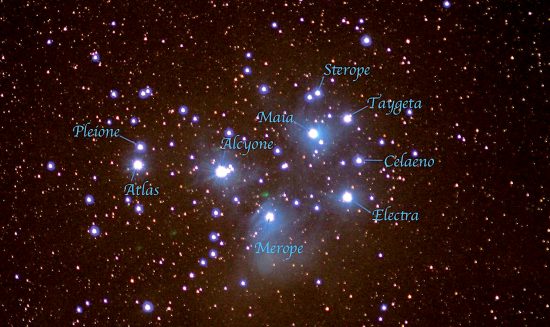
May 26, 2020
The Seven Sisters, or M45, is a misty cluster of stars.
Commonly known as the Pleiades, modern astronomers believe that constellation’s stars were born in the same nebular cloud about 100 million years ago. The cluster contains more than 1000 stars, although only 14 are visible to the naked eye. It was known to the ancients, deriving its name from Greek mythology: the “seven sisters” were the daughters of Atlas, the Titan.
The Pleiades cluster is embedded in a cloud of ionized gas and dust that consensus astronomers say evolved from thousands of blue-white supergiant explosions millions of years ago. The supernovae “compressed gas and dust” in nearby regions, which jump-started the formation of other bright stars in a 2000 light-year wide ring. Known as Gould’s Belt, the ring also includes many nebulae: the Orion Molecular Cloud and the Bug Nebula, for example, along with the Pleiades and several star clusters in the constellation Scorpius.
Astronomers think that the reason for the tendril-like formations within the cloud surrounding the Pleiades is starlight “pushing” on tiny dust grains. Smaller particles experience a greater repulsion than larger ones, so they are thought to sort themselves according to their inertia.
In previous Picture of the Day articles, it was argued that nebulae and star formation are not the result of compression, shock waves, coalescence, or any other gravity-centric models that are rampant in cosmology today. As recently reported, stars are said to require cold gas to form, otherwise thermal energy would impart too much outward pressure, preventing thermonuclear reactions.
There is no adequate mechanism in modern astronomical theories that can form nebulae and their energetic emissions. Astrophysicists do not know how stars “eject” their outer layers, thereby causing gas clouds to compress and form other stars. The reason for that lack of understanding is that nebulae are not composed of inert gas, cold or hot, but of plasma.
About 75% of the interstellar medium (ISM) is composed of hydrogen (molecular or atomic), and the remainder is helium. The ISM is partly neutral atoms and molecules, but a portion of it includes charged particles. If portions of a dusty gas cloud are ionized, then charge separation will build-up in nearby regions, forming a plasma.
As written many times in these pages, when plasma moves through a cloud of dust and gas it initiates an electric field and the flow of electric charge. Electricity moving through any substance forms magnetic fields that tend to align and constrict the current. In an Electric Universe, plasma and magnetic fields form electric stars through enormous field-aligned currents that power the galaxy, preventing plasma from dispersing inside their light-years long helical coils. When electric charge density inside those filaments gets high enough, the plasma glows and “pinches” into plasmoids that could become stars.
When electrical stress is low and the plasma cloud also possesses some dust, only the stars in a nebula “light up” in arc-mode discharge. Where electrical stress is greater, as in M45, filaments, jets, and surrounding gas can also light up. Of course, dust clouds can reflect the light from nearby stars, but the Pleiades filaments and cell-like behavior are characteristic of plasma in laboratory experiments.
Stephen Smith
The Thunderbolts Picture of the Day is generously supported by the Mainwaring Archive Foundation.












